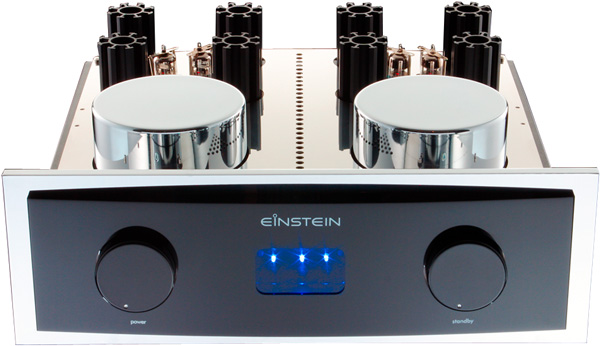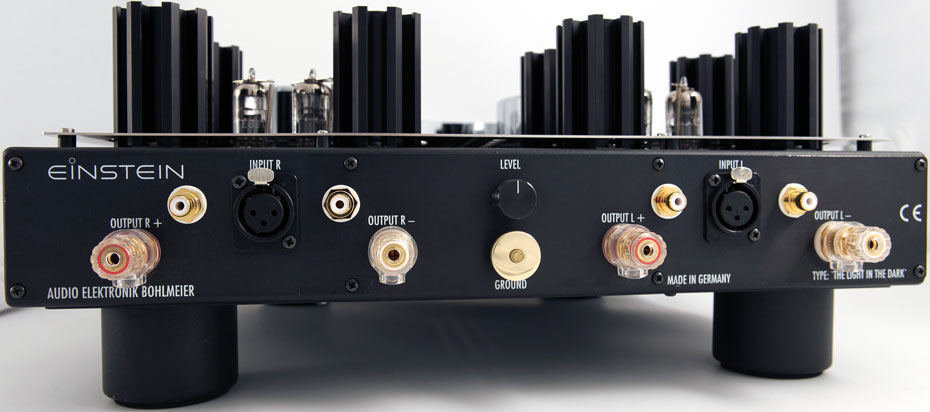He was considered a virtual idiot; after all, he wasn’t able to speak coherently until about age 12. He majored in classroom mayhem and proved to be an adept kleptomaniac. Who would have thought he would be enlightened to derive the theory of general relativity? My mind ponders such things when I hear Einstein Audio’s The Light In The Dark amplifier described as producing, “…detailed musical information, and fast explosive dynamics… absolute quietness.” What might Einstein have thought had he heard such an amplifier?
You may think I am going to lean heavily upon the famed scientist for illustrative purposes. Well I’m not, because the Einstein The Light In The Dark is notjust inspired by the man, but rather a rock. In German, the phrase ein stein means “one stone”. Per Einstein Audio, its goal is to make a covet-inducing component of worthy bling-factor and sound attraction as to be comparable in beauty to a precious stone. It is also the goal of the company to supply (predominantly) men dazzlingly beautiful components so that they can have their extravagances as audacious as a huge diamond ring. It doesn’t hurt that the scientist is so well known worldwide; as effectively as any logo or brand, it indicates German design.
Gimme the rock!
When I selected my wedding ring I wanted a diamond in it; not just a chip, but an actual stone. My logic was if I’m wearing it for the rest of my life I want it to be pleasing, just as I want my marriage to be impressive in its quality and beauty. Mywedding band had to be special.
Then I went and lost it. Idiot! Moron! Fool! I muttered all these things for two days as I swept through the house, retraced my steps across the city and cursed myself for losing the one, my preciousssss ring. Two months later, I pulled out a pair of pants to wear and as I lifted them from the hanger I heard a “ping” on the floor. Instantly I knew what it was – my ring with the Rock! YES! I had recovered it! Of course, this makes me look dim for not finding it in that pair of pants earlier. I had checked the pants in my closet repeatedly by patting them down and scrunching the pockets to no avail. What I learned in the long run was that it was as effective in recovery as the time I lost my wallet from my sweatpants in a McDonald’s PlayLand ball pit. It could not be found through thrusting hands into the sea of balls and swishing around to feel it. The restaurant had to send in two workers to empty the pit to recover the wallet. The loss of the wallet was frustrating, but the loss of the ring was agonizing; what it symbolizes means the world to me.
Audiophiles may become quite attached to their gear. A component is so well loved, so precious that it becomes to the mind a bespoke item, a personal Chagall or Faberge. That is the cache which Einstein Audio wants to create around its components. Ah, but is The Light In The Dark in actuality a Cubic Zirconia in disguise? Will it prove to be precious or preposterous? Is it the real thing or an imitator?
What’s in a name?
Einstein Audio components are developed by a team including owner Volker Bohlmeier, engineer and designer Rolf Weiler, professional musician and recording engineer Thomas Erkelenz, and Volker’s wife, Annette Heiss. Recognition of the team’s efforts was evident in its first product, “The Amp”, which garnished two Product of the Year awards in Japan during the 1990’s. The Light In The Dark is highly refined aesthetically and operationally. Very few components I have worked with exhibit such a high degree of simplicity in use and extreme quality in sound. After several weeks with the amp I’m convinced if diamonds are a girl’s best friend, then The Light In The Dark may be an audiophile’s best friend; it’s not a diamond, but in it’s own inimitable way just as valuable.
Considering the amplifier’s name, since when are components given phrases for names? The company’s name should be an indicator that nothing is mundane about Einstein components. Instead, The Light In The Dark prods me to think of a more romantic time in the industrial era, somewhere in the 1950’s, when even toasters had character! Kitchens and car lots had not been plasticized and mechanical devices were to be appreciated to behold, not just functional to use. Similarly, the façade of The Light In The Dark has a techno-artistic nature to it, with gleaming chrome against a piano black gloss background. Gently arcing panels give way to the forward positioned cylindrical transformer covers. Behind them the delicately caged tubes with their associated heat sink towers can be seen. While thoroughly contemporary, the amp bespeaks a time when not everything operated via a circuit board.
Two oversized dials, Power on the left and Mute on the right, flank the deeply tinted central display window. Its purpose is to show three blue LED pinpoint lights, nothing more. When the amp is turned on, the three LED’s are all lit, indicating Warm Up/Protection Mode. Once accomplished, the Left and Right LEDs extinguish, but return when MUTE is engaged.
I appreciate the slim contour of The Light In The Dark; it is a refreshing departure from the myriad of mind-numbing boring boxes used altogether too frequently today. One can grasp the approximately 45-pound unit firmly, moving it about with confidence. Note that the balance point is quite forward toward the front, due to the reversed topology of tubes and transformers, said to improve the signal path. The smart central perforated line on the chrome cover brings a simple elegance to the unit. Underneath, a mandatory right angle power cord fits into the chassis on the left side as one faces the amp, another accommodation to optimum design. Nearly a foot of power cord length is committed to this placement, so if your power cord normally would just reach the back of the amp, you will either be moving The Light In The Dark closer to the outlet or you will have no music at all, seeing as the cord will be too short.
The amp was delivered with the stock cord, which I initially took for a variant of Kimber Kable but learned was Einstein’s own. Color me impressed, as this was a serious stock cable, not some throwaway. Brian Ackerman of Aaudio Imports, distributor of Einstein Audio equipment, seems to be a stickler for details – no one else has ever sent along an envelope containing a pre-addressed return shipping label with business card. Having made a visit to Brian’s home while at RMAF two years ago, I recalled seeing his nearly immaculate “warehouse” – storage area. I nearly had the impression that, if necessary, guests could be seated on the floor! Likewise, his listening room was spotless, not a cable or component out of place. (See 2009 Aaudio Imports Visit. –Ed.) That tidiness is apparent in the selection of components Brian chooses to carry as a distributor. Seeing clean-lined examples of work from Lindemann, Acapella and Isoclean convinced me that it’s more than just business when Brian sets his mind to assemble a fine system. The additional Isoclean Focus power cable, one of a few makers of right-angled power cords, was much appreciated. It extended the capabilities of the amplifier nicely. The Isoclean cord brought greater clarity and heft to the amp’s sound.
As a dual mono design, the backside splits the inputs to their Left and Right respective sides (one set of XLR; two sets of RCA), such that one can either use the RCA inputs as non-reversed or reversed polarity. The Light in the Dark is “fully differential” according to the Owner’s Manual, and as such use of the XLR inputs are preferred. If one chooses to use the RCA inputs, an initially, mildly confusing configuration presents itself: One sees both white and red RCA posts at both the Left and Right inputs. To operate the amp in non-inverting phase both of the L/R red inputs are used, and conversely, to invert phase both L/R white inputs are used. This is a handy solution to amplifiers which invert phase. While using single-ended cables, I preferred the non-inverting connections, although I used the XLR inputs the bulk of the time.
An “INPUT LEVEL CONTROL”, a front-end loaded attenuator, allowing for complementary use of The Light In The Dark with another amplifier in bi-amping configurations is found centrally located on the back. I appreciated this feature especially with use of the Ayon CD-5, which itself has an unusual feature, a GAIN switch. The tube preamplification output stage of the CD-5 can be selected between 4V, 6V, or 8V. When used in conjunction with the VAC Signature MkII Preamplifier (itself a Class A1 amp) and The Light in the Dark, the CD-5 had a tendency to step up the signal with too much gain, such that it began to fall apart and become perceptually distorted due to the over-expansion of the soundstage. Adjusting the input of The Light In The Dark helped correct that effect. It should be noted that I did not have the same “over-cooked” result when the CD-5 was used directly into the amp, a configuration I preferred for its pristine nature. Enthusiasts should take note that it is possible to have too much gain even in extremely high-end gear. I usually opted for the Low (4V) output of the CD-5 to ameliorate the issue.
- (Page 1 of 3)
- Next page →




Hello can i used First Sound for Einstein?